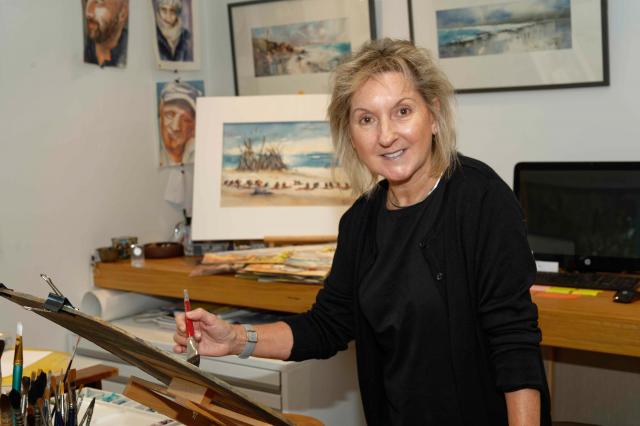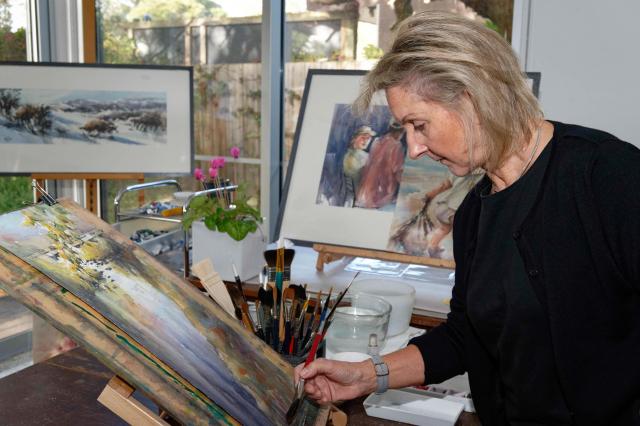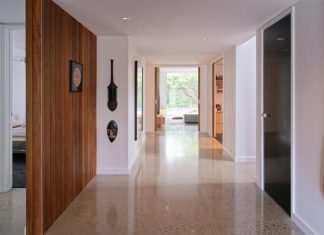Barwon Heads artist Alison Fincher has been chosen to exhibit at the prestigious FabrianoInAcquarello in Italy. She speaks with JUSTIN FLYNN about her journey from a farm in the north of the state to being a renowned artist.
Tell me about the FabrianoInAcquarello and how you got selected to exhibit.
The Australian Watercolour Muster called for works from watercolourists from around Australia. They are part of the FabrianoInAcquarello network. It happens in May and June each year.
The Australian Muster calls for contributions from watercolour artists and the one I did called ‘Tidewater’ was nominated last year as one of the 30 best that they pick out of many entries.
They nominate them to go to Italy for the Fabriono, the Italian exhibit.
The past couple of years they have done that physically but this year it’s had to be digital because with COVID and all the turbulence in Europe, they couldn’t send them over physically this year because they have had a backlog in getting the last two years’ paintings back to Australia. They didn’t want to compound the issue so they are doing it digitally this year.
That must be a proud moment for you?
The year before I put a painting in the Australian exhibition and it was a finalist but it didn’t go on through this process, but it’s the first time I have had one nominated for Italy so that’s quite exciting.
I’ve had the good fortune to go over to Italy painting for a few weeks on a couple of occasions so I’m hoping to do that again possibly next year.
I would have loved to be over there this year, but next year hopefully.
What are some local places that are inspiring as a painter?
I often ride my bike around Barwon Heads and if you go along Carr Street, there’s a couple of places that you can walk through to the river, for example, at the end of Geelong Road. Often you get amazing light effects because we get some fabulous skies in Barwon Heads which are really great for watercolour painting.
Sometimes depending on the time of day and the nature of the weather, you get amazing light off the water.
Tell me where you grew up?
I was born in a place called Boort near Kerang. Most people don’t know where Boort is. I lived in country Victoria until I was midway through secondary school and a couple of years up in Mildura, but I’ve had a lifetime association with the Bellarine because my mother’s family are from the Western District so we always came down here for holidays.
I’ve been coming down here on and off for a lot of my life because my parents have a house here.
Were you artistic as a child?
I always liked painting and drawing as a child. That came from a more academic family and my father was a skilled amateur photographer, but it was more as a hobby. When I finished school I studied design and wanted to do something more arty so I did more painting and drawing, but it’s been intermittent as life came along and then a professional career.
In more recent years, probably in the last 10 years, I’ve been able to get back into it and in the last few years I’m pretty much full time which is quite exciting.
When did you realise you were good at this?
I don’t know whether I’ve realised I’m any good to be honest. You’re always evolving. I guess I could always draw otherwise I would never have undertaken studies in the arts or design field.
It’s like anything, the more you do, the more you realise you don’t know and the more there is to learn.
Apart from the Italian exhibition, what’s on the radar for you?
The Bellarine Arts Trail hasn’t been on for the last two years, but I will be participating in that this year. It’s such a nice event that people can go to to look at all different sorts of work. It’s great having it all available on one day because it makes it worth coming down to the Bellarine to have a look.
The last two years there’s been a thing called Geelong Design Week and last year they approached the Arts Council to see if they would like to do an open studios trail and I participated in that but we only had eight or 10 people.
There were a few more this year and most of the feedback from the people who participated was that they think it is a good idea to continue to be involved with that.
Those two events it’s my intention to participate.
Do you have to be in a certain mood to work?
I personally have to have a piece of space, so when I’m hysterically running from one place to another and have a busy week, I can’t just say ‘well I have half an hour and I’ll just pop in and do some more on that painting’. You have to have an off space and say ‘I’m just going to do this’.
Different things work depending on which mood I’m in. It works quite well for me to have a canvas going and some watercolours as well, because I can move between the two.
The thing about watercolour is you have to wait for it to dry. If you keep on loading stuff on it, it gets muddy so if you put a layer down you really need to let that dry before you put some more on.
Before you became a full-time artist, what did you do?
Lots. I was originally an interior designer and then I was director of an architectural practice for a long time and I was also involved in administration with the Victorian Arts Council and then in more recent years I moved into being in charge of university buildings, director of facilities and services for universities and left that and went into my own consultancy and over the last few years I’ve moved into doing this full time.
Do artists view the world differently to other people?
I think everyone sees things through their own filter and you see that with the choices that people make. Sometimes I think ‘why did you choose that one to buy?’ but people will often choose something that means more to them for a particular reason and not just purely for the aesthetics.
So with a sunflower painting, somebody might look at that and think it’s a lovely picture because they have family in Ukraine so it will have an additional meaning.
What do you like doing away from your art?
I enjoy skiing. I also sing in the Brunswick Women’s Choir and have been for 14 years. It rehearses every week so I do need to go up for those and the director of that choir also lives on the Bellarine now. She moved down to St Leonards a couple of years ago.
What’s the future hold for you?
I’m looking forward to getting into portraiture a bit more. I haven’t really done a lot of portraiture painting. I started doing some in lockdown.
A lot of your paintings seem to be outdoorsy. Why is that?
I find certain landscapes really moving. I think that makes me want to record it in some way. I go up to Falls Creek every year and it’s so beautiful up there. Every single year when I’m standing at the top of the summit and it’s a beautiful day I get my phone out and take photos. It’s ridiculous because I take 100 photos every year, but I can’t help it. It’s so amazingly beautiful and it’s a bit like that down here. The light across the mouth of the river here just this side of the bridge at certain times of day or certain kinds of weather you get a shaft of light coming through an amazing sky, you just can’t help but stop and do something about it.
Painting water is a challenge. You keep on doing it and doing it to try and to capture that it’s often about the light and where the light is. What you want to reflect in the painting is that light and energy and creating a painting isn’t copying a photo or a scene, it’s taking that and manipulating it to convey that to the viewer and often you have to exaggerate things and diminish others in order to get that across.
How do we learn more about you?
Go to alisonfincher.com.au







